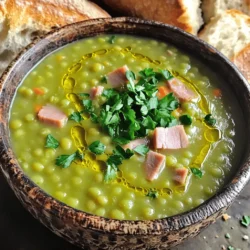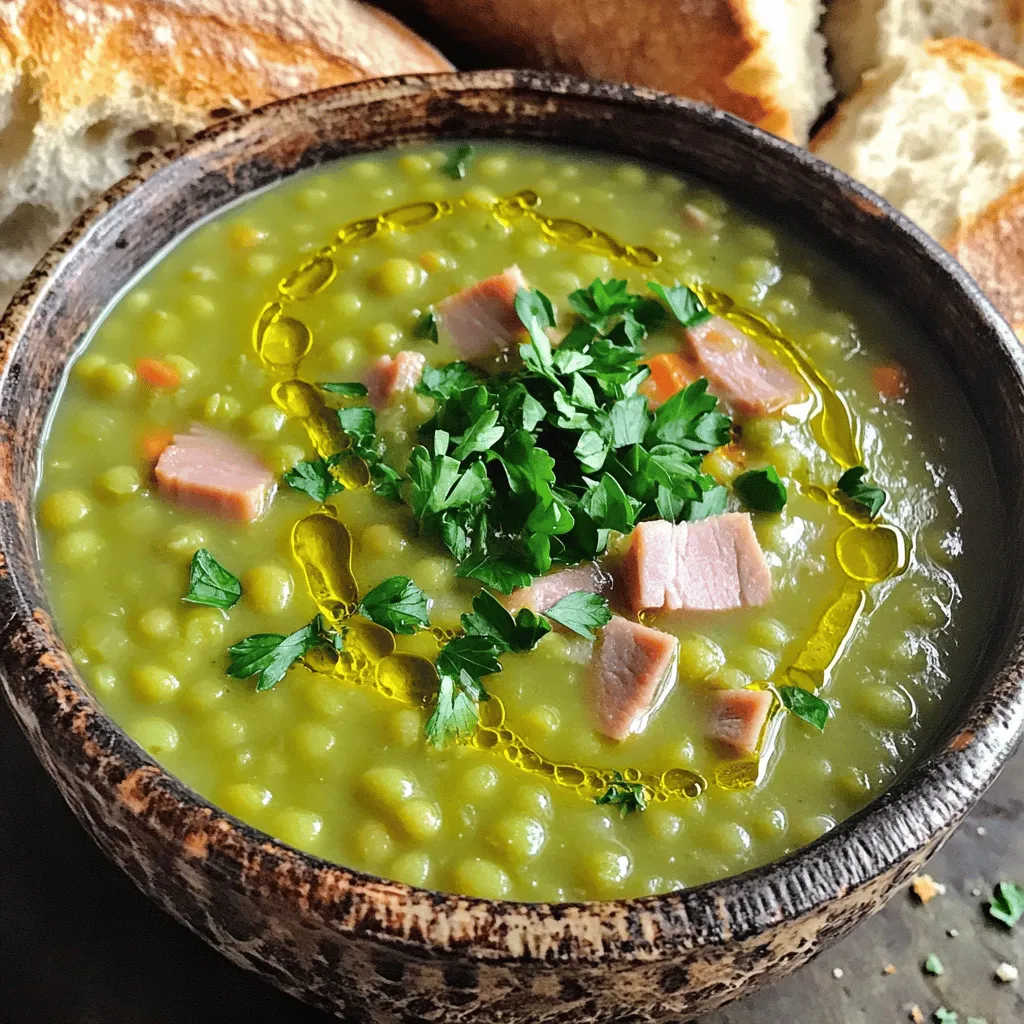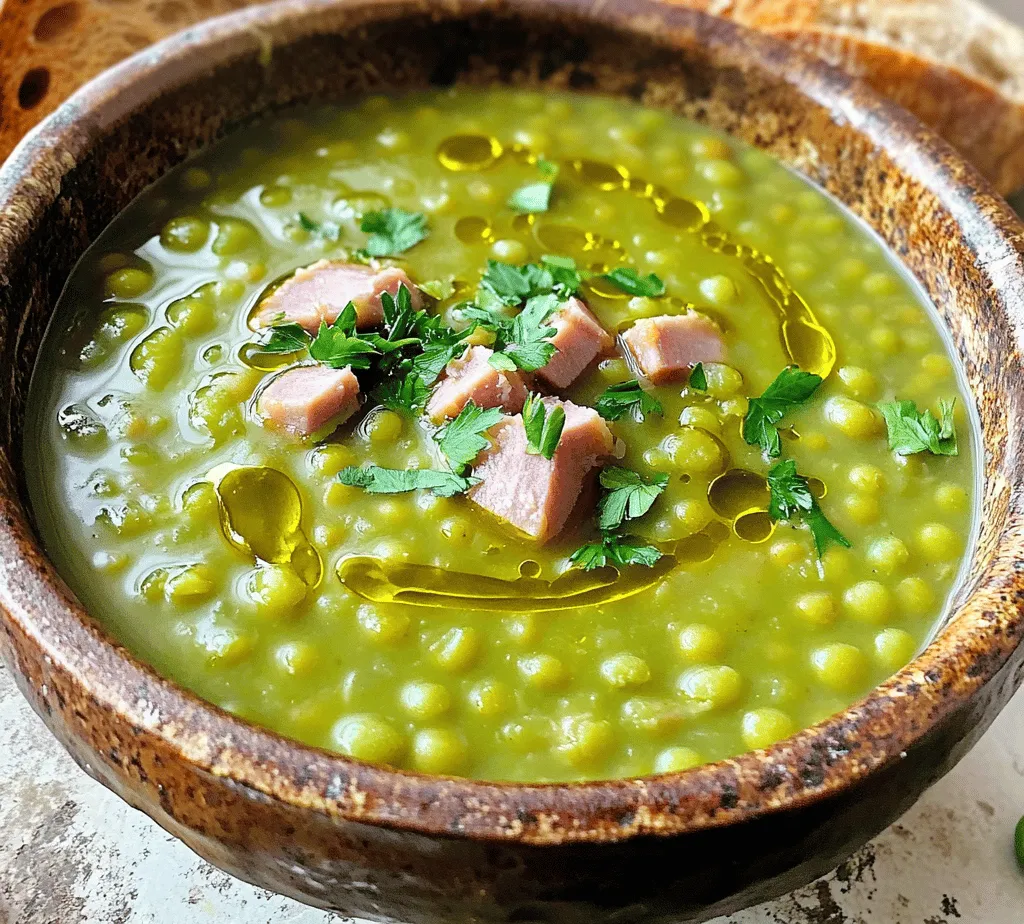Exploring the Comfort of Hearty Split Pea & Ham Soup
As the seasons change and the chill of winter sets in, there’s nothing quite as comforting as a warm bowl of soup. Among the myriad of soup options available, Hearty Split Pea & Ham Soup stands out as a classic favorite. This dish not only warms the soul but also delivers a robust flavor profile that can please even the pickiest of eaters. With its rich, savory taste and creamy texture, this soup is an ideal choice for family dinners or cozy gatherings.
Split pea and ham soup is more than just a delightful meal; it serves as a reminder of home-cooked comfort food. The combination of split peas, tender pieces of ham, and assorted vegetables creates a dish that is both filling and satisfying. As you savor each spoonful, you’ll discover the layers of flavor that develop during the cooking process, making it a true culinary experience.
Beyond its comforting qualities, this soup is also packed with nutritional benefits. Split peas, the star ingredient, are a powerhouse of protein and fiber. They are low in fat and provide essential vitamins and minerals, including iron, magnesium, and potassium. When combined with ham, which contributes additional protein and flavor, this soup becomes a nourishing option that can fuel you on the coldest of days.
Moreover, the simplicity of making Hearty Split Pea & Ham Soup makes it accessible for cooks of all skill levels. With just a handful of ingredients and a bit of patience, you can create a dish that is both hearty and wholesome. Whether you’re looking to warm up after a long day or searching for a satisfying meal to share with loved ones, this soup is sure to deliver.
Understanding the Ingredients
Exploring the Key Components of Split Pea & Ham Soup
To create a delicious and fulfilling Hearty Split Pea & Ham Soup, it is essential to understand the ingredients that contribute to its unique flavor and texture. Let’s delve into each component that transforms simple ingredients into a comforting masterpiece.
Split Peas: Nutritional Value and Cooking Properties
The foundation of this soup lies in the split peas. These small, dried legumes are packed with nutrition. A single cup of cooked split peas contains about 16 grams of protein and 16 grams of fiber, making them an excellent choice for promoting satiety and digestive health. They are also low in fat and calories, making them a perfect addition for those looking to maintain a healthy diet.
In terms of cooking properties, split peas are incredibly versatile. They soften quickly during cooking, which allows them to break down into a creamy consistency that forms the base of the soup. Unlike other legumes, split peas do not require soaking prior to cooking, which makes them even more convenient for weeknight meals.
The Role of Vegetables: Onions, Carrots, Celery, and Potatoes
While split peas are the star of the show, the supporting cast of vegetables enhances the flavor and texture of the soup. Onions, carrots, and celery are the holy trinity of soup-making, providing a flavorful base that adds depth to the broth. Caramelizing the onions, in particular, brings out their natural sweetness, balancing the savory notes provided by the ham and broth.
Potatoes are another common addition to this soup, offering a hearty texture and additional starch that contributes to the overall creaminess. They also help to absorb the flavors of the broth and other ingredients, making every spoonful a delightful experience.
Importance of Broth: Choosing Between Vegetable Broth and Water
When it comes to creating the perfect broth for your soup, you have a choice: use vegetable broth or plain water. While water will certainly work, opting for a flavorful vegetable broth will enhance the overall taste of the soup. Broth infuses the dish with additional layers of flavor, making it more satisfying and complex.
If you prefer a richer flavor profile, consider using chicken broth or ham broth, if available. These options can elevate the dish further, especially with the incorporation of ham. Whichever you choose, ensure the broth is low in sodium to allow better control over the seasoning of the final dish.
The Significance of Ham in Adding Flavor and Protein
Ham is a quintessential ingredient in Hearty Split Pea & Ham Soup, providing both flavor and protein. Its smoky, savory notes complement the earthiness of the split peas beautifully. Using leftover ham from a holiday meal or purchasing a pre-cooked ham hock can save time and enhance the flavor of your soup.
The type of ham you use can also influence the taste. Choose a smoked variety for a more robust flavor or a honey-glazed ham for a touch of sweetness. Regardless of the choice, the ham should be cut into small, bite-sized pieces to ensure even distribution throughout the soup.
Seasoning Essentials: Thyme, Bay Leaf, Salt, and Pepper
No soup is complete without the right seasonings. Thyme and bay leaves are classic herbs that complement the flavors of split peas and ham perfectly. Thyme adds a subtle earthiness, while the bay leaf infuses the soup with a slightly herbal, aromatic quality.
When seasoning, start with a moderate amount of salt and pepper, adjusting to taste as the soup simmers. Remember, the ham will impart some saltiness, so it’s best to err on the side of caution initially. Additional herbs and spices, such as garlic or smoked paprika, can also be added for a personalized touch.
Garnishing with Fresh Parsley: Enhancing Visual Appeal and Flavor
Once your Hearty Split Pea & Ham Soup is cooked to perfection, consider garnishing it with fresh parsley before serving. This simple addition not only enhances the visual appeal of the dish but also adds a pop of freshness that can brighten up the rich flavors of the soup. Fresh herbs can also provide a boost of nutrients, making your soup not only delicious but even healthier.
Preparation Steps
Step-by-Step Guide to Making Hearty Split Pea & Ham Soup
Now that we’ve established the importance of each ingredient, let’s dive into the preparation of this delicious soup. Follow these steps to create your own Hearty Split Pea & Ham Soup, bringing warmth and comfort to your table.
Initial Sautéing Process
Begin by preparing your ingredients: chop the onions, carrots, celery, and potatoes into uniform pieces to ensure even cooking. The first step in the cooking process is to sauté these vegetables. In a large pot or Dutch oven, heat a tablespoon of olive oil over medium heat. Add the chopped onions to the pot, stirring occasionally.
Sauté the onions for about 5-7 minutes, or until they become translucent and slightly caramelized. The goal here is to build a flavor base that will enhance the overall soup. Once the onions are softened, add the diced carrots and celery, cooking for an additional 3-4 minutes until they are tender.
Importance of Caramelizing Onions for Flavor
Caramelizing the onions is a crucial step in developing the depth of flavor in your soup. As the onions cook down, their natural sugars caramelize, creating a sweet and savory foundation. Make sure to keep an eye on them to prevent burning, as burnt onions can impart an undesirable bitterness to the dish.
Incorporating Vegetables: Tips for Optimal Cooking
After the onions, carrots, and celery have cooked down, it’s time to incorporate the diced potatoes. Stir them into the pot and allow them to cook for another 3-4 minutes. This helps to soften the potatoes slightly before introducing the split peas and broth.
At this stage, you can also add minced garlic if desired, allowing it to cook for about a minute until fragrant. This step is optional but can elevate the flavor profile significantly.
Preparing the Split Peas and the Addition of Broth
Next, rinse the split peas under cold water to remove any debris or dust. After rinsing, add the split peas to the pot, stirring to combine with the sautéed vegetables. Pour in the broth of your choice, ensuring it covers the ingredients by at least an inch. If you prefer a thicker soup, use less broth.
Cooking Down the Soup: Simmering Techniques for Best Results
Bring the mixture to a boil, then reduce the heat to low and cover the pot. Allow the soup to simmer gently for about 45 minutes to an hour, or until the split peas are tender and have broken down, creating a creamy texture. Stir occasionally to prevent sticking, and feel free to add more broth or water if the soup becomes too thick during cooking.
Adjusting Seasoning: How to Taste and Modify Flavors
As the soup simmers, taste it periodically to adjust the seasoning. After about 30 minutes of cooking, add the thyme, bay leaf, salt, and pepper. Continue to simmer for the remaining time, allowing the flavors to meld beautifully.
Remember that seasoning can always be adjusted at the end, so start conservatively, especially with salt, since the ham will contribute its own saltiness.
Texture Variations: Achieving the Perfect Texture: Chunky or Creamy?
One of the great things about Hearty Split Pea & Ham Soup is that you can customize the texture to your liking. Some prefer a creamy consistency, while others enjoy a chunkier version with more visible pieces of vegetables and ham.
If you opt for a creamier texture, consider using an immersion blender to puree part of the soup once the split peas are tender. This allows you to achieve that velvety mouthfeel without losing all the chunky goodness. Just blend until you reach your desired consistency, being careful not to over-puree if you want to retain some texture.
Conversely, if you enjoy a chunkier soup, simply skip the blending step and serve the soup as is. The choice is yours, and both variations are equally delicious!
By following these steps and understanding the ingredients that make Hearty Split Pea & Ham Soup so special, you’re well on your way to creating a warm and satisfying dish. Get ready to embrace the comfort of this classic recipe, perfect for family gatherings, weeknight dinners, or simply to enjoy on a chilly day.



